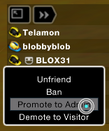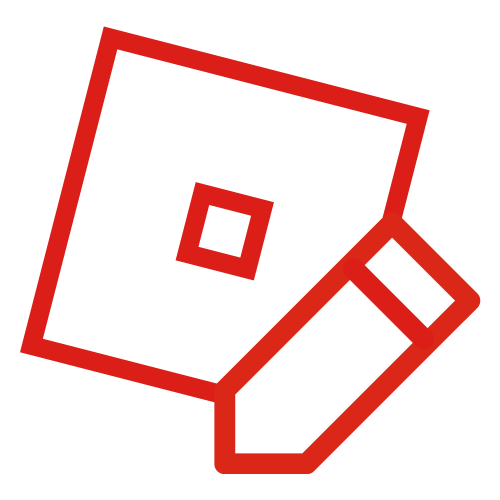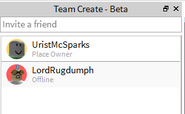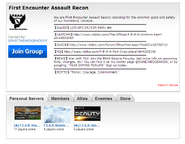
Personal Server sign.
Personal Servers was a feature used on Roblox that allowed players to usually build whatever they want in-game and have it save on its own. Lots of players were able to join and help build with the owner of the game. Some restrictions though were applied such as who can visit, who can build, and who is banned. Oftentimes, personal servers were made mostly of terrain, with few non-terrain blocks rarely used for anything other than functionality.

The newest personal server icon.
Users must have been subscribed to a Builders Club membership tier before making a Personal Server. However, all players were able to join a personal server. When the place owner's Builders Club expires, the server is still kept, but another server cannot be made and if the place is changed into a regular game, it cannot be made a Personal Server until the owner got Builders Club again.
Without a concrete reason, personal servers were discontinued on June 8, 2016, according to a message from ROBLOX and on the forums.
History

ROBLOX RALLY-Three ROBLOX administrators introduce personal servers at the 2011 ROBLOX Rally.
Personal servers were first introduced by Njay, ostrichSized, and gen2integri at the 2011 ROBLOX Rally. The feature was fully released on November 2, 2011.[1] On May 26, 2016, it was discontinued to be replaced with Team Create.
Features
ROBLOX describes a personal server as "a game that never closes."[2] Unlike a regular game place, when a server closes when all players have left, a personal server never closes. Therefore, the personal server never reverts to the way it was before users started playing it; this creates the opportunity for personal servers to be used as collaborative building projects. Personal servers can be changed back to a game place and vice versa.
The following is a chart explaining the differences between a personal server and a game place:
| Personal Server | Game Place | |
|---|---|---|
| Autosaves | ||
| Single Instance | ||
| Public by Default | ||
| Private by Default | ||
| Access Privileges | ||
| Ban List | ||
| Gear Allowed | ||
| Tickets Awarded for Visitors Before Removal | ||
| Builders Club to Create | ||
| Free to Play |
Access Levels

How to promote/demote a user within a personal server
- The owner and administrators can assign access levels to specific users via clicking the player's name on the leaderboard. These access levels dictate what permissions that player has and what he can and cannot do within the personal server.
The following is a chart explaining the certain permissions various access levels have within a personal server:
| Banned | Visitor | Member | Admin | Owner | |
|---|---|---|---|---|---|
| Ability to play game | ✖ | ✔ | ✔ | ✔ | ✔ |
| Ability to use build tools | ✖ | ✖ | ✔ | ✔ | ✔ |
| Ability to promote/demote other users* | ✖ | ✖ | ✖ | ✔ | ✔ |
| Ability to add and remove administrators | ✖ | ✖ | ✖ | ✖ | ✔ |
*Except promotion/demotion of administrators
It is advised to use caution when promoting players. Any changes they make to the server, whether constructive or destructive, will be automatically saved, unless the place's version has been changed to another non-destructed version.
Personal Servers within Groups
Personal Servers can be associated with particular groups. A feature of personal servers allows membership and admin can be awarded to members of a group with a certain rank or above. Like associating a place with a group, associating a personal server with a group makes that personal server appear on the group's page.
The Personal Server Culture
In many Personal Servers, big communities formed. They would create a roblox group to, manage all the new people and divide the permissions among them.
External tools like scripted admin, F3X and custom build tools were inserted into the games, as alternatives to the traditional stamper tool.
popular genres started to form. trends such as School, battle, family, and town roleplays began to appear. Mini-building servers, obbies and free- builds were also in huge popularity. There were also standard genres put in place by large communities, such as Nation-states, PBS servers, and Military groups were briefly observed. All these genres contained the essence of the personal server culture.
Thestamper tool enthusiasts were amongst the biggest players. They built mainly using the stamper tool, embracing its simple nature. they often employed wiring contraptions and great computers; devices that ran on inputs and outputs. Float pads for example, were often employed to power devices ranging from simple rockets to more complex mechanisms such as multi-floor elevators and claw machines.
Online cities were the most popular hubs to be. It often was a mixing bag of the other genres, as if all other genres could exist in cities. cities formed close relationships with other cities on the website. online cities would continuously develop and grow. In their wake, nations emerged.
Criticisms and Issues
An issue with Personal Servers were griefers. This often occured in Personal Servers in which building rights were handed out too freely. Griefers would sabotage a place by flooding it with water or blowing up structures using C4 and explosive gear. This was easily remedied by removing the building rights of the person and reverting back to an earlier version before the griefing.
Personal Servers were often claimed to be a useless feature saying that many types of games on Personal Servers were also done in normal places. Many types of games such as, quiz games, RP games, and minigame places, were often run on Personal Servers due to the ease of setting such games up on the feature. These places often relied on hosts interacting with the other players, while many regular places automated the processes using scripts. This argument ignores the fact that the host interaction is often what set Personal Servers apart.
The stamper tools that came with Personal Servers were also prone to develop bugs overtime. There are examples such as, cloning a brick connected to a larger structure would cause the structure to erratically shift and deform, moving a brick connecting to a larger structure using the 4x4 movement option would do something similar to the clone tool problem, structures built using the basic building blocks would start to develop strange cracks and slowly shift as more was added to the structure, and the wiring tool and configure tool were prone to no longer work in servers with many bricks forcing a reset. These issues were completely ignored by Roblox who most likely wanted to deemphasize the Personal Server feature and emphasize normal places.
Team Create
Main Article: Roblox Studio
Team Create is a similar to Personal Servers, in that it allows collaborative building, except players are restricted to building in Roblox Studio instead of being able to do so in-game along with their avatars, and players need to invite others to build with them. Team Create was first announced in a blog post on April 13, 2016, while it was in Beta. It is released. Here are several images of Team Create:
Differences between Personal Servers and Team Create
- On Personal Servers, players had access to the stamper tool and whichever other tool inside their inventory because their avatar was present, while on team create players do not have access to their avatar.
- Personal Servers had access levels restricted to different players, but team create does not.
- Personal Servers allowed the users to build in-game with their avatar instead of in studio like Team Create.
- Personal Servers had an extra megaphone-like tool that would create thumbnails, like a camera, but this feature isn't available on Team Create.
- While every player can join a Personal Server (except players who are banned from the server), players must be invited to a Team Create.
Gallery
References
- ↑ ROBLOX Blog, Your Own Personal Server, Version 1.0, http://blog.roblox.com/2011/11/your-own-personal-server-version-1-0/
- ↑ ROBLOX, What is a Personal Server?, https://en.help.roblox.com/hc/en-us/articles/203314010-What-is-a-Personal-Server-




